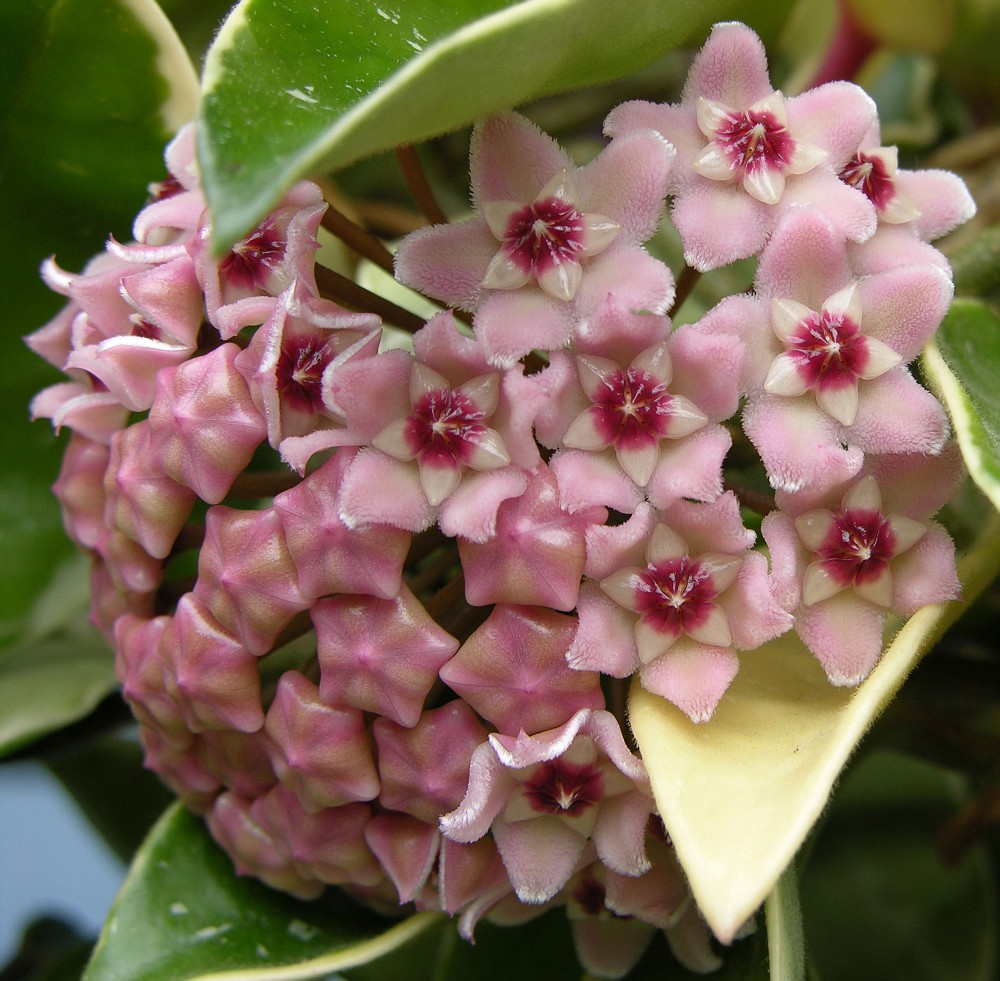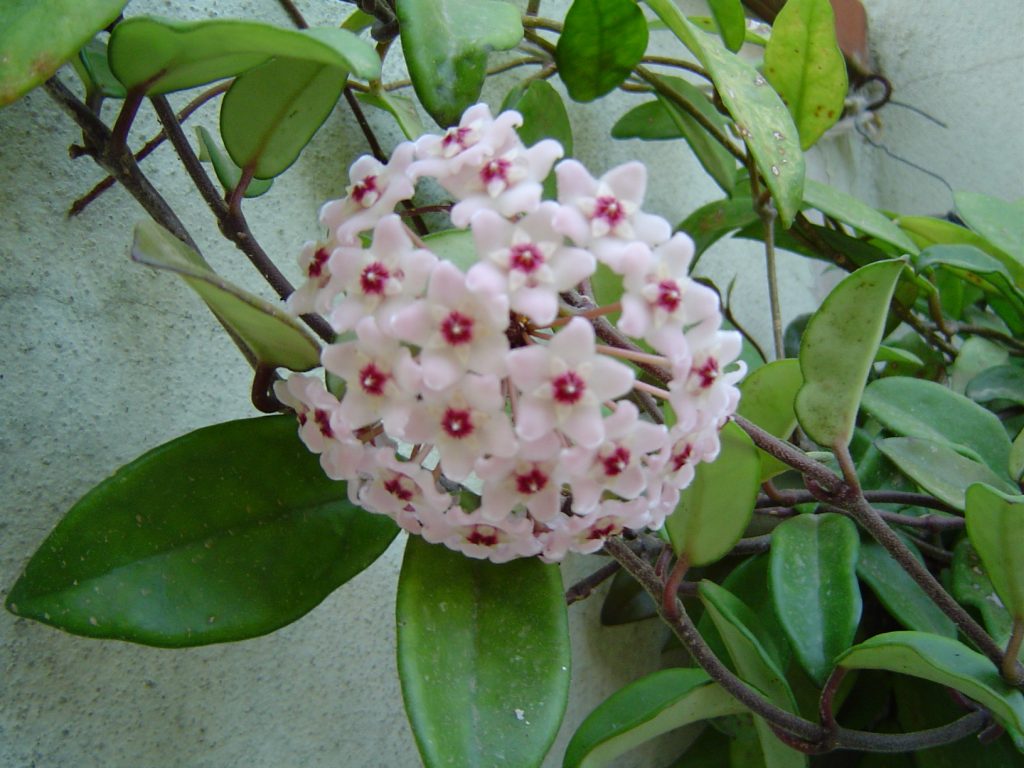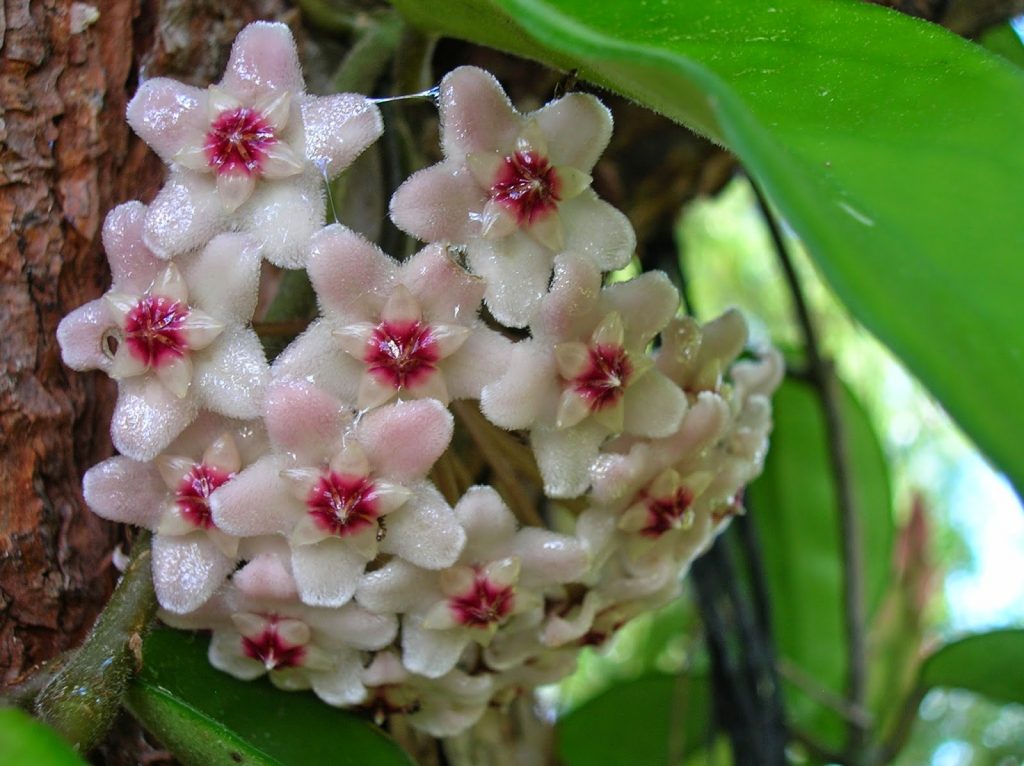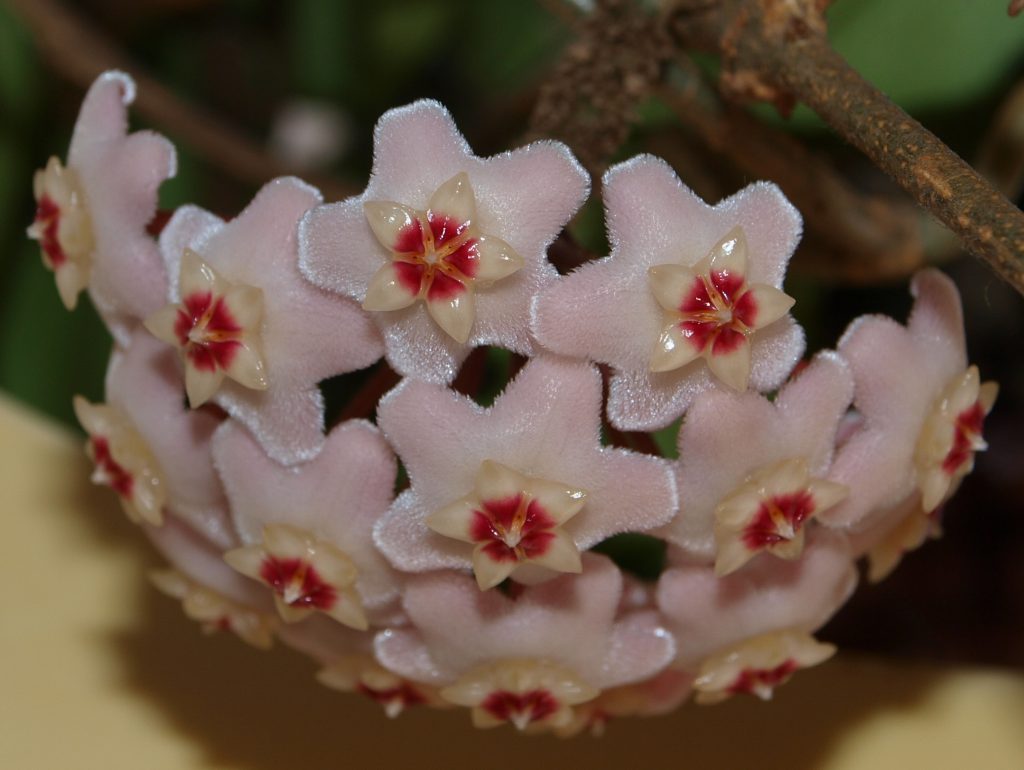Hoya Karnosa - rules of care and methods of reproduction
The decorative hoya Karnoza is one of the brightest among the representatives of the Kutrov family. The plant was named after its discoverer Thomas Hoya, who cultivated flowers in greenhouses. Consider a detailed description of the species, its varieties and home care rules.
- general characteristics
- Signs and superstitions
- Varieties
- Tricolor
- Krimson Queen
- Compacta
- Variegata * Variegata)
- Suzi Q
- Gray Ghost
- Crinkle
- Exotica
- Holliana
- Wilbur graves
- Brazil
- Stardust
- Purchase and adaptation
- Landing rules
- The necessary conditions
- Humidity
- Temperature
- Illumination
- Care rules
- Watering
- Top dressing
- Pruning
- Transfer
- Reproduction methods
- Cuttings
- Sheet
- Stem layering
- Diseases and pests
- Useful videos

Hoya carnosa variegated
general characteristics
The second name is Hoya Meaty; lat. Hoya carnosa.
This species can be distinguished from other varieties by several characteristics:
- has a massive, branched root system that grows quickly and fills all the space in the pot;
- flowering occurs only after the roots completely encircle the soil;
- the stem is curly, densely ramified, the length can reach 10 m;
- leaves are thick, fleshy, pointed at the tips, emerald shade, size 8-9 cm;
- flowers in the shape of stars, consist of five sharp petals, with a circumference of 2 cm, collected in inflorescences-umbrellas of 15-20 pcs.
- the color of the buds, depending on the variety - red, snow-white, pink.
It blooms in early June and ends in July. Blooming starts again in September. Blooming liana thinns the pleasant sweetish aroma.
The flowers are very decorative, it seems as if they are made of wax, which is why hoyi are also called wax ivy.
Signs and superstitions
This plant has a positive effect on the general condition of a person, so it can be grown in any room.
According to popular beliefs, a flower has a beneficial effect on the atmosphere at home, enhances the harmony of the world view and improves family relationships, and establishes a bond between loved ones and relatives. It also normalizes sexual and psychological relationships between spouses.
Varieties
There are several attractive varieties that are adapted to the home environment.

Hoya meaty
Tricolor (Tricolor)
Fleshy hoya with decorative foliage - the main tone is red, the edging is snow-white. As they grow, the leaves in the center acquire a yellowish tint.
Krimson Queen Queen)
It blooms with small pale pink flowers with pale pink edging. The buds are collected in dense umbrellas.
The stems of the Crimson Queen variety are green, curly, the leaves are fleshy, glossy, emerald hue.
Compacta
Another unique decorative type with creeping stems, densely covered with curly foliage. The color of the leaves is rich green, the surface is glossy.
It blooms with small flowers with a diameter of 2 cm, collected in dense umbrellas. The marginal petals on the buds are light pink, the crown is purple.
During the flowering phase, the hoya thinns the pleasant honey smell.
Variegata *Variegata)
This variety is distinguished by variegated, curly foliage, densely covering the twisting stems. The leaf plate is fleshy, emerald in color, along the edge there is a clear edging of grayish, cream or white.
The shoots are purple, thin.
Suzi Q
This variety has curly shoots, thin, purple color, slightly leafy. The leaves are multi-colored - cream or beige below with a lilac tint, above - emerald with a thin white border around the edges.

Hoya carnosa tricolor
Gray Host (Gray Ghost)
Translated from English means - a gray ghost. Liana hoya with brown, thin, curly shoots. Dense, fleshy leaves with a glossy surface develop along the entire length of the stems. The color is dark green with a grayish tint.
Crinkle
The stems are thick, purple in color, completely covered with fleshy foliage of an emerald hue.
The leaves grow in different directions - concave inward or outward, giving the plant a curly appearance. The flowers are pale pink, with a lilac crown, collected in dense umbellate inflorescences of 20-25 pcs.
Exotica
A liana-shaped flower that can be grown with or without a support. Possesses decorative multi-colored foliage of lilac or light green tones with emerald color edging.
Unlike other varieties, it grows very slowly - an annual growth of 10-12 cm
Holliana (Holliana)
The leaves of this plant are bright green, shiny develop in different directions, densely cover the curly stems. The edges of the plate are creamy.
Wilbur graves
An exotic variety with variegated foliage. A leaf plate of medium length - 8-9 cm, width - 3-4 cm. The surface is smooth, emerald, covered with light green spots, specks and strokes.

Hoya carnosa home care
In adult specimens, a light green tone with elements of a dark green hue predominates on the leaves.
Brazil (Brazil)
Differs in intensive growth - in a year the shoots can be extended by 40 cm. The leaves are fleshy, 10 cm long. The main color is dark green with a silvery coating.
The flowers are large - 2.5-3 cm in diameter. Collected in loose inflorescences. The shape of the buds is in the form of beige bells, with a five-pointed burgundy crown in the center.
Stardust (Stardust)
Translated from English means "stardust". A very beautiful evergreen vine with light brown, dense stems that branch out from numerous shoots closer to the tip.
Each branch is covered with leathery emerald leaves with elements of light green tone.
Purchase and adaptation
You can buy one of the types described above in a specialized store. To get a healthy flower, which in the future will delight you with rapid growth and colorful flowering, you need to carefully examine it.

Hoya carnosa compact
The criteria for choosing a quality copy are as follows:
- stems of a solid color, without cracks, breaks, outgrowths;
- leaves are juicy, rich in tone in accordance with the variety, do not contain yellow, black or brown spots, blotches;
- the substrate is slightly damp, without mold and acidification on the surface.
It is better to buy flowering plants, so you will surely know that in front of you is exactly the variety that you need. In addition, a flower with inflorescences indicates the absence of health problems.
After the purchase, the hoya is placed in another room - a three-week quarantine will benefit her. During this time, she will get used to home conditions, and you can determine if she has diseases and parasites.
Landing rules
To plant wax ivy, take not too high flowerpots made of ceramic or plastic with drainage holes. This is a liana-like culture, so it is better to use a pots for growing.
The soil is suitable fertile and loose - mix leafy, soddy soil and humus in a ratio of 3: 2: 2. Many are planted in a ready-made store substrate intended for indoor palms and orchids.
In the wild, the plant grows in sunny places, so at home it should be placed on a windowsill on the south or southeast side. At lunchtime, you will need protection from scorching rays so that the leaves and inflorescences do not burn.
The necessary conditions
For full-fledged growth, high-quality and long-term flowering of hoye carnose, several conditions must be provided

Hoya carnosa crimson queen
Humidity
This plant is from tropical countries, so it prefers to grow at high humidity - about 75-80%. This can be ensured by regularly sprinkling the crown with warm water. In spring and summer, the frequency is every three days. In the cold season, they are irrigated twice a month.
Sprinkling washes away dust, stimulates the growth of greenery and stems, and prevents the appearance of spider mites.
Temperature
Throughout the growing season - from spring to autumn, the temperature is suitable for the flower - in the range of 23-27 ° С.
In winter, when the plant slows down, it is kept cool at 15-16 ° C.
It easily tolerates drafts, but does not tolerate sudden changes in temperature, therefore, at the time of airing the room in the cold season, it is moved to another place.
Illumination
Lack of light can negatively affect the general state of the carnose hoya - it begins to shed buds and foliage. The optimal duration of a light day is 8-10 hours throughout the year.
In spring and summer, the flower is placed in a place where there is diffused light in the morning and evening. In winter, illuminate with a fluorescent lamp - set at a distance of 0.5 m from the crown.
Care rules
All types of wax ivy need the same care - regular nutrition, hydration and loosening.

Hoya carnosa variegata photo
Watering
This plant tolerates a lack of moisture more easily than an excess of it. Therefore, it is watered abundantly, but only after the soil has dried to a depth of 4-5 cm. In spring and summer, the frequency is after seven days.
With the onset of autumn and throughout the winter, they are moistened less often - once every 2-3 weeks. The water accumulated in the pan is drained to avoid root rot.
Use settled or filtered water at room temperature. The next day, surface loosening of the substrate is carried out so that it does not crust over and pass oxygen and moisture well.
Top dressing
An exotic liana does not like overfeeding, so it should be fertilized only during the period of budding and flowering. Mineral fertilizers are used alternately with organic matter. Store-bought preparations for feeding orchids and palms are suitable.
It is applied every three weeks in combination with watering to improve the quality of nutrient absorption and to avoid burning the roots.
Pruning
Hoya carnosa does not tolerate this procedure well and may die, so it is not worth pruning the shoots and flower arrows on which new inflorescences will appear next year.
Cut out only those parts that are dry, rotted, yellowed or damaged by infections, parasites.
Transfer
After purchase, the plant is given time to adapt, then transplanted into a new pot 2-3 cm in diameter larger than the previous one. For transplantation, take a fresh and disinfected soil mixture.
Blooming hoya should not be disturbed, because it may not tolerate stress and will die. You need to wait for the inflorescences to dry out. The procedure is carried out by the method of transshipment of an earthen coma.
Also, home flowers need to be transplanted - every three years with the change of the old soil to a new one. It is important not to damage the delicate root system, since it will quickly disappear and the hoya will wither away.
Diseased plants with rotted roots are transplanted. First, they water it, then pull it out of the flowerpot, wash off all the soil, cut out non-viable roots, dip in a fungicide solution for half an hour.Dried, planted in a new pot with a sterile substrate.
Reproduction methods
Hoya can be propagated in several ways at home - if all the rules are followed, each one gives a positive result.

Hoya karnosa gray host
Cuttings
Cutting of planting material is carried out in the spring or summer in the phase of active growth. They choose strong stems without signs of infection with diseases and mechanical damage. Segments 15-20 cm long with several leaves and buds are cut off. In the lower part, all the foliage is removed, dipped in Kornevin's solution for an hour.
The shoots are planted in a loose peat-sand mixture (1: 1) to a depth of 2-3 cm, moistened, placed in the light and kept at a temperature of 22-25 ° C.
In order for the seedlings to take root faster, they are watered regularly. After about 2-3 weeks, they will begin to develop new leaves - a sign that they have taken root. They are grown for another month, then they are seated from separate pots.
Sheet
Several leaves with an axillary bud are separated from the stem. Immersed in a solution of Kornevin or Heteroauxin for 10 minutes. They are planted in a mixture of peat and sand mixed in equal amounts. Sprinkle with warm water, cover with foil.
The mini-greenhouse is ventilated every day, as the substrate dries, it is moistened. After about 2 weeks, the leaves will release the first roots, but they can be planted only after the stems appear. The development of shoots will take 1.5-2 years.
Stem layering
Another effective propagation method, which is used for adult plants from the age of 5 years.
Choose the strongest and most flexible shoot, make an incision on it 1-1.5 cm long. Wrap it with wet moss, then cover it with a film.
As soon as the first roots break through the moss, the shelter is removed, the stem is separated from the mother flower, planted in a peat-sand mixture.
Diseases and pests
Throughout the year, this indoor flower can be damaged by various infections and parasites. The main reason is violation of the rules of care and maintenance. With timely detection, the plant can be saved.
| Diseases and pests | Symptoms | Treatment methods | Prophylaxis |
| Spider mite | The microscopic insect feeds on the sap of leaves, buds, braids the lower part of the shoots and leaves with a small cobweb. The damaged areas are deformed, shriveled, turn yellow and dry out | At the initial stage of infection, they are washed with soapy foam or a solution of laundry soap (40 g per 1 liter of water). The advanced stage is treated with acaricides - Aktellik or Aktara | Increase humidity, lower temperatures, irrigate the crown regularly, especially on hot days |
| Aphid | It settles in colonies on the underside of the leaves, multiplies en masse, loves to feast on the juice of young foliage, buds, shoots. Damaged organs turn yellow, curl and crumble | If the flower is not running, it is treated with an infusion based on tobacco, orange peels or soapy water. Severely affected specimens are sprayed with chemistry - Karbofos, Fitoverm or Aktara | Buy healthy plants, quarantine, regularly loosen the soil and inspect the crown for pests |
| Mealybug | A whitish coating on the surface of the leaves is the first sign of infection. Small white parasites feed on the tissues of leaves, buds, as a result of which they turn black and die off. They can also parasitize on the roots. | Such a plant needs to be urgently removed, cut out all damaged parts on the roots and crown. Immerse the root system in a fungicide solution for 2 hours, then dry it and transplant it into a new pot with sterile soil mixture. Additionally spray with Fitoverm or Fundazol | Use disinfected soil for planting and transplanting, avoid overflows and cut off rotten, yellowed twigs, leaves in time |
| Shield | You can identify it by reddish or brown growths in the form of plaques on the leaves, stems. The insect sucks out the juices, in the affected areas the plant turns black and dies | Remove non-viable organs, treat with Decis twice with an interval of 7 days | Regularly cut off dried, rotten twigs, periodically loosen the substrate, buy healthy plants, water on time, feed |
| Powdery mildew | A whitish coating on the surface of all parts is a sure sign of the appearance of a fungal infection. Over time, damaged areas darken, become covered with condensation and rot | Cut out dubious leaves, shoots, treat the crown and soil with Skor, Hom or a solution of colloidal sulfur | Before buying, carefully inspect the flowers, keep in quarantine, regularly transplant into sterile and fertile soil, avoid overflow |
| Root rot | This disease affects vines, which are often poured with cold water. The root is supercooled and begins to rot. Later, the rot spreads to the stems - they become watery, soft, darken | The plant is pulled out of the pot, if the root system is completely rotted, it is disposed of, I first cut off a few cuttings or leaves for rooting. With a slight lesion, rotten roots are cut out to healthy tissue, dipped in a fungicide solution for an hour, dried and transplanted into a new flowerpot with a disinfected substrate | Avoid waterlogging, use warm water for irrigation |

